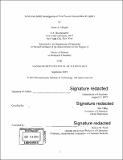Solid-state NMR investigation of viral fusion glycoprotein 41 (gp41)
Author(s)
Morgan, Chloe A.(Chloe Anne)
Download1142100051-MIT.pdf (5.691Mb)
Alternative title
Solid-state nuclear magnetic resonance investigation of viral fusion glycoprotein 41 (gp41)
Other Contributors
Massachusetts Institute of Technology. Department of Chemistry.
Advisor
Mei Hong.
Terms of use
Metadata
Show full item recordAbstract
Protein-mediated membrane fusion is an integral part of numerous cellular processes and viral entry. The HIV envelope glycoprotein mediates viral entry into target cells by fusing the viral envelope with the cell membrane. This process requires large-scale and multi-step conformational changes of the viral fusion protein gp41. Our current understanding of the mechanisms of protein-induced membrane structural changes involved in viral entry is incomplete because the hydrophobic N-terminal fusion peptide (FP) and C-terminal transmembrane domain (TMD) of gp41 have resisted structure determination. In our study, we expressed a gp41 construct, "short NC", containing both hydrophobic termini, including the FP, the fusion-peptide proximal region (FPPR), the membrane-proximal external region (MPER), and the TMD, together with a truncated water-soluble ectodomain linking the N and C termini. In order to probe the membrane-bound topology and conformation of gp41, we reconstituted "short NC" gp41 into a virus-mimetic membrane for solid-state NMR experiments. ¹³C chemical shifts of ¹³C isotopically labeled residues indicated that the C-terminal MPER-TMD region is predominantly [alpha]-helical, whereas the N-terminal FP-FPPR exhibits [beta]-sheet character. Water and lipid ¹H polarization transfer to the protein revealed that the TMD is well inserted into the membrane, while the FPPR and MPER are more hydrated and exposed to the membrane surface. Importantly, we observed correlation signals between the FP-FPPR and the MPER, providing direct evidence that the ectodomain is sufficiently collapsed to bring the N- and C-terminal hydrophobic domains into close proximity. These results support a hemifusion-like structural model of gp41 in which its ectodomain forms a partially folded hairpin that places the FPPR and MPER on the opposing surfaces of two lipid membranes that are in close proximity.
Description
Thesis: S.M. in Biological Chemistry, Massachusetts Institute of Technology, Department of Chemistry, 2019 Cataloged from PDF version of thesis. Includes bibliographical references (pages 33-36).
Date issued
2019Department
Massachusetts Institute of Technology. Department of ChemistryPublisher
Massachusetts Institute of Technology
Keywords
Chemistry.